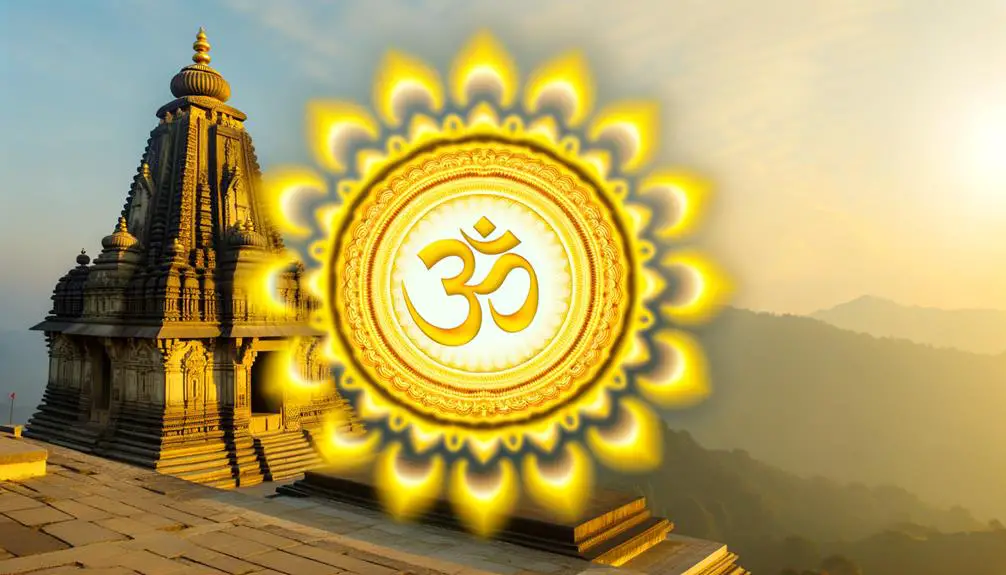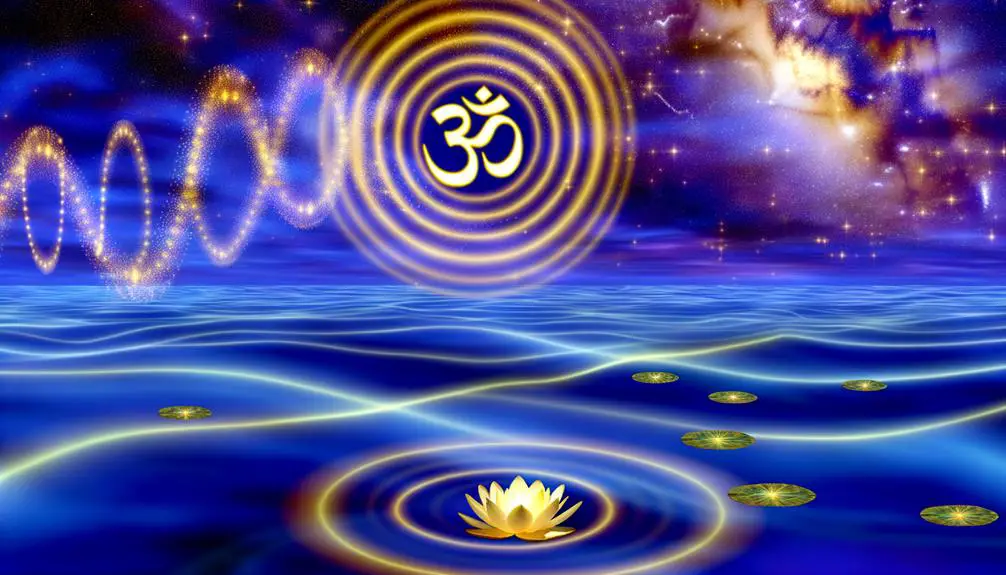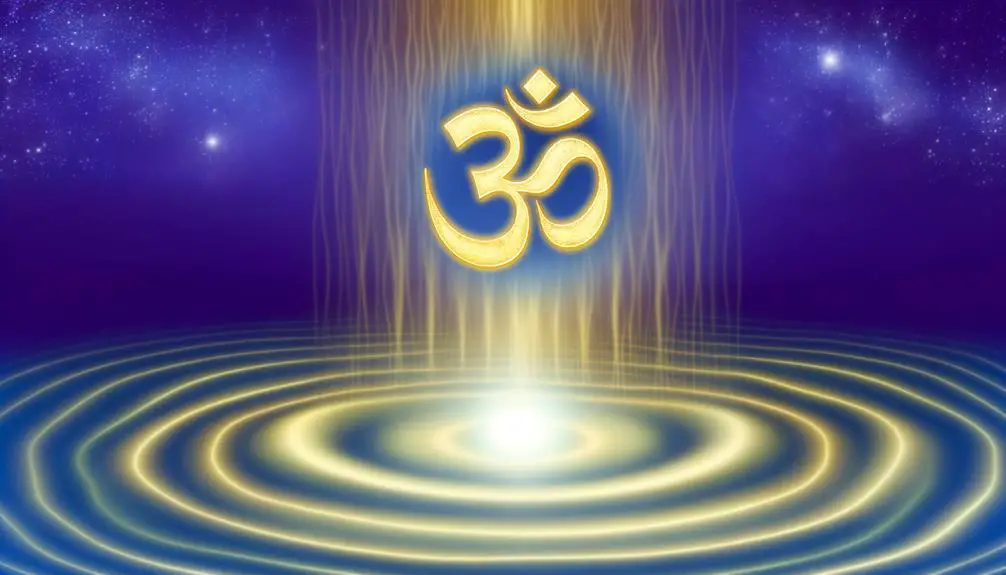What is the Meaning of the Om Symbol in Hinduism?
The Om symbol, with roots in ancient Vedic texts like the Rigveda, signifies the primordial sound of the universe and the essence of ultimate reality. The Mandukya Upanishad explores its profound spiritual essence, representing various states of consciousness: waking, dreaming, and deep sleep, with a transcendent state symbolized by a dot.
In Hinduism and Buddhism, Om is integral to rituals, meditation, and mantras, fostering tranquility and spiritual enlightenment. Chanting Om aligns with the universe's inherent frequency, promoting mental clarity and holistic well-being.
Investigating further offers a deeper understanding of Om's multifaceted significance.

Key Takeaways
- Om represents ultimate reality and self, encapsulating past, present, and future.
- The symbol's components depict waking, dreaming, and deep sleep states, with a dot signifying transcendence.
- Om is a primordial sound found in ancient Vedic texts, embodying cosmic creation and consciousness.
- In Hinduism and Buddhism, Om signifies interconnectedness and is central to meditation and spiritual practices.
- Chanting Om aligns with natural harmonics, promoting mental clarity, emotional balance, and spiritual awareness.
Origins of Om

The Om symbol, a sacred syllable in Hinduism, Buddhism, and Jainism, traces its origins to the ancient Vedic texts of India, dating back to approximately 1500 BCE. Found in the Rigveda, one of the oldest known scriptures, Om is described as the primordial sound from which the universe originates.
Scholars such as Frits Staal highlight its phonetic significance in Vedic chanting and rituals. The Mandukya Upanishad, a later text, further expounds on Om, presenting it as the essence of ultimate reality (Brahman) and the self (Atman).
This profound connection between sound and metaphysical concepts underscores Om's foundational role in Indian spiritual thought, transcending mere symbolism to embody cosmic principles and meditative practices.
Symbolic Representation

The symbolic representation of the Om symbol intricately combines various elements, each imbued with profound spiritual significance. Scholarly interpretations often emphasize the visual components, such as the three curves, the semicircle, and the dot, which collectively embody the states of consciousness and the ultimate reality.
Elements of Om Symbol
Comprising various curves, a semicircle, and a dot, the Om symbol encapsulates profound philosophical concepts and spiritual significance deeply rooted in Hindu tradition. Each element of the symbol represents different aspects of existence and consciousness. The larger lower curve signifies the waking state (A), while the middle curve denotes the dream state (U). The upper curve symbolizes deep sleep (M), and the dot above the curves represents the transcendent state, known as Turiya. The semicircle below the dot symbolizes Maya, the illusion that separates the absolute state from the three states of consciousness.
| Element | Representation |
|---|---|
| Lower Curve | Waking State (A) |
| Middle Curve | Dream State (U) |
| Upper Curve | Deep Sleep State (M) |
| Dot | Transcendent State (Turiya) |
| Semicircle | Maya (Illusion) |
Spiritual Significance Explained
Understanding the individual elements of the Om symbol is fundamental to appreciating its profound spiritual significance, as each component collectively represents the journey of the soul towards ultimate enlightenment. Rooted in the ancient Vedic texts, Om symbolizes the essence of the universe and the eternal truth.
The syllable 'AUM' encompasses the three stages of consciousness:
- A: The waking state (Jagrat)
- U: The dream state (Swapna)
- M: The deep sleep state (Sushupti)
These elements signify the interconnectedness of all existence. Additionally, the silence following the chant represents Turiya, the transcendent state of pure consciousness.
This holistic representation underscores Om's pivotal role in meditative and spiritual practices, guiding individuals towards self-realization and cosmic harmony.
Visual Interpretation Details
Delving into the visual composition of the Om symbol reveals a rich tapestry of symbolic elements, each meticulously crafted to convey profound spiritual truths. The symbol comprises three curves, a semicircle, and a dot, each representing different states of consciousness and aspects of the universe.
| Symbolic Element | Interpretation |
|---|---|
| Large lower curve | Waking state (Jagrat) |
| Middle curve | Dream state (Swapna) |
| Upper curve | Deep sleep (Sushupti) |
| Semicircle | Maya, the illusion |
| Dot | Absolute state (Turiya) |
The large lower curve signifies the waking state, wherein consciousness is turned outward. The middle curve denotes the dream state, reflecting inward focus. The upper curve represents deep sleep, while the semicircle symbolizes Maya, the veil of illusion. The dot epitomizes Turiya, the transcendental state beyond consciousness.
Om in Hinduism

In Hinduism, the Om symbol holds profound significance as it encapsulates the essence of the universe and the ultimate reality. Often invoked at the beginning and end of sacred texts, prayers, and ceremonies, Om is revered as a primordial sound representing the cosmic vibration that underpins all existence. Its recitation is believed to align the practitioner with the divine frequency, fostering spiritual awakening and inner peace.
- Scriptural References:
Frequently mentioned in the Vedas and Upanishads.
- Meditative Practice:
Utilized in yoga and meditation for focus and tranquility.
- Philosophical Concept:
Symbolizes the interconnectedness of all life.
- Ritualistic Use:
Integral in rituals, mantras, and religious rites.
- Spiritual Symbolism:
Embodies the triune nature of the universe—creation, preservation, and dissolution.
Om in Buddhism

The Om symbol in Buddhism, though less central than in Hinduism, still holds considerable importance, particularly within certain Mahayana and Vajrayana traditions where it is integrated into mantras and meditative practices.
In Vajrayana Buddhism, Om precedes sacred mantras like 'Om Mani Padme Hum,' invoking the embodiment of compassion, Avalokiteshvara. Scholarly interpretations suggest that Om represents the universal sound and the interconnection of all phenomena, aligning with the Buddhist concept of interdependent origination (pratītyasamutpāda).
The syllable is often employed in meditation to cultivate mindfulness and focus. According to academic sources, such as the works of Dr. Alexander Berzin, the Om syllable in Buddhist practice serves as an aural symbol, offering a gateway to deeper spiritual experiences and enlightenment.
The Sound of Om

The sound of Om, often characterized by its unique vibrational frequency, is believed to resonate with the fundamental frequency of the universe, as supported by studies in quantum physics and metaphysics (Feuerstein, 1996).
Its spiritual significance is multifaceted, encompassing notions of cosmic creation and universal consciousness, which are central to various Eastern philosophies (Eliade, 1958).
Additionally, the practice of chanting Om has been shown to offer numerous benefits, including enhanced mental clarity, emotional stability, and overall well-being, making it a cornerstone of meditative disciplines (Kumar, 2010).
Vibrational Frequency Explained
A fundamental aspect of the Om symbol's significance lies in its unique vibrational frequency, which is often described as the primordial sound of the universe.
This vibrational essence is believed to resonate at 432 Hz, a frequency theorized to align with the natural harmonics of the cosmos.
Scholarly studies and ancient texts suggest that chanting Om creates a sonic environment conducive to mental clarity and physical well-being.
Primordial sound: Represents the universe's origin.
432 Hz frequency: Aligns with cosmic vibrations.
Mental clarity: Chanting aids focus and mindfulness.
Physical well-being: Enhances physiological health.
Harmonic resonance: Synchronizes with natural rhythms.
This intricate interplay between sound and vibration underpins the Om symbol's profound cultural and metaphysical import.
Spiritual Significance Unveiled
Understanding the spiritual significance of the Om symbol necessitates a deeper exploration of its auditory and metaphysical dimensions, which intertwine to create a holistic experience transcending mere sound. As elucidated in the Mandukya Upanishad, Om embodies the entirety of cosmic existence: the waking, dreaming, and deep sleep states.
The sound of Om, through its phonetic components A-U-M, represents the triadic nature of creation, preservation, and dissolution (Rig Veda). This primordial sound is believed to align the practitioner with the fundamental vibration of the universe, fostering spiritual awakening and unity with the divine consciousness.
Scholarly interpretations, such as those by Swami Sivananda, emphasize that Om serves as a bridge between the material and spiritual domains, enhancing meditative practices and inner peace.
Chanting Practices Benefits
Chanting the sacred syllable Om can yield profound physiological and psychological benefits, as evidenced by numerous studies in the fields of neurotheology and cognitive science. This primordial sound has been shown to activate the vagus nerve, thereby promoting relaxation and reducing stress levels. Furthermore, resonating Om has been found to enhance focus and cognitive performance, aligning the practitioner's mental and emotional states. The vibrational frequency of Om can synchronize brain hemispheres, fostering holistic well-being.
- Stress Reduction: Stimulates the parasympathetic nervous system, reducing cortisol levels.
- Enhanced Focus: Improves attention span and cognitive function.
- Emotional Balance: Alleviates symptoms of anxiety and depression.
- Spiritual Connection: Deepens meditative states, facilitating spiritual growth.
- Holistic Health: Harmonizes physiological and psychological processes for overall wellness.
These benefits underscore Om's multifaceted impact on human well-being.
Spiritual Significance

The spiritual significance of the Om symbol transcends mere phonetic expression, embodying the essence of the universe and the interconnectedness of all existence as elucidated in ancient Vedic texts.
According to the Mandukya Upanishad, Om represents the past, present, and future, encapsulating the totality of time and space. This symbol is viewed as an auditory manifestation of Brahman, the ultimate reality.
Scholarly interpretations suggest that the three phonetic components—A, U, and M—correspond to the waking, dreaming, and deep sleep states of consciousness. The silence following the chant signifies the fourth state, Turiya, which is a transcendental reality.
This profound symbol serves as a meditative focus, facilitating spiritual awakening and a deeper understanding of universal truths.
Om and Meditation

Integral to many meditative practices, the Om symbol serves as both a focal point and a vibrational tool that facilitates deep states of mental clarity and spiritual connection. The sonorous chant of 'Om' is believed to resonate with the primal sound of the universe, aligning the mind with cosmic vibrations.
Scholarly references highlight its capacity to induce a meditative state by:
- Slowing the breath and heart rate
- Enhancing concentration and mindfulness
- Reducing stress and anxiety levels
- Promoting emotional stability and inner peace
- Heightening spiritual awareness and insight
Research on mantras underscores that the repetition of Om can activate the parasympathetic nervous system, thereby fostering relaxation and mental acuity. This vibrational resonance is central to its efficacy in meditation, bridging the gap between the individual and the universal.
Om in Yoga Practice

Incorporating the Om symbol into yoga practice goes beyond mere physical postures, as it encompasses symbolic chanting that fosters mindfulness and meditation, creating a holistic experience (Feuerstein, 2008).
This practice not only aids in aligning the mind and body but also deepens spiritual connection, facilitating a journey towards self-realization and inner peace (Eliade, 1958).
The vibrational essence of Om serves as a bridge to transcendental states, enhancing the overall efficacy of yoga as a spiritual discipline (Saraswati, 1996).
Symbolic Yoga Chanting
Chanting the sacred syllable Om during yoga practice serves as a profound tool for aligning the mind, body, and spirit, drawing from millennia of spiritual and philosophical traditions.
This practice is deeply rooted in Vedic literature and Upanishadic teachings, where Om is considered the primordial sound of the universe. Engaging in symbolic chanting can enhance the depth of one's yoga experience by promoting:
- Energetic Balance: Harmonizes the chakras, facilitating energy flow.
- Mental Clarity: Focuses the mind, reducing distractions.
- Physical Relaxation: Relaxes the nervous system, easing tension.
- Spiritual Connection: Deepens the sense of unity with the cosmos.
- Breath Regulation: Synchronizes breath patterns, enhancing prana circulation.
These elements illustrate the transformative potential of Om in fostering holistic well-being through yoga.
Mindfulness and Meditation
Employing the sacred syllable Om within mindfulness and meditation practices in yoga serves as a pivotal method for cultivating present-moment awareness and deepening meditative states. The vibrational resonance of Om is said to harmonize the mind, body, and spirit, facilitating an internal environment conducive to mindfulness. Scholarly references, such as those found in the Journal of Consciousness Studies, indicate that the repetition of Om can stimulate neural pathways associated with relaxation and self-awareness. This practice aligns with the principles of Patanjali's Yoga Sutras, which emphasize the importance of sound in meditation.
| Aspect | Benefit | Scholarly Reference |
|---|---|---|
| Sound Vibration | Enhanced Relaxation | Journal of Consciousness Studies |
| Neural Activation | Improved Self-awareness | Neuropsychology of Meditation |
| Mantra Repetition | Increased Focus | Patanjali's Yoga Sutras |
| Mind-Body Harmony | Stress Reduction | International Journal of Yoga Therapy |
Spiritual Connection Deepening
Frequently revered in yogic traditions, the sacred syllable Om serves as a profound tool for deepening one's spiritual connection through its multifaceted applications within yoga practice. Om's vibrational resonance harmonizes the mind, body, and spirit, promoting a state of inner peace and heightened awareness.
Scholarly studies highlight its impact on the parasympathetic nervous system, inducing relaxation and reducing stress (Kalyani et al., 2011). Additionally, Om chanting facilitates the unification of consciousness, aligning practitioners with the universal energy.
Key benefits of incorporating Om in yoga practice include:
- Enhancing meditative focus and mindfulness.
- Promoting emotional stability and resilience.
- Synchronizing breath and movement for deeper physical practice.
- Cultivating a sense of unity and interconnectedness.
- Elevating spiritual awareness and insight.
These elements underscore Om's integral role in enriching yoga practice.
Om in Modern Culture

In recent years, the Om symbol has transcended its traditional spiritual and religious connotations to become a ubiquitous element in contemporary wellness practices, fashion, and popular culture. Scholars note its integration into yoga studios, meditation apps, and holistic healing centers (Smith, 2018).
Additionally, the symbol's aesthetic appeal has led to its adoption in jewelry, tattoos, and clothing, often devoid of its original context (Jones, 2020). This cultural diffusion raises questions about appropriation versus appreciation, suggesting a need for more informed engagement (Brown, 2019).
Understanding Om's profound origins can enhance its modern usage, bridging ancient wisdom with contemporary relevance, and fostering a deeper respect for its spiritual significance.
Incorporating Om in Daily Life

Recognizing the cultural diffusion of the Om symbol, it is pertinent to explore how individuals can meaningfully incorporate Om into their daily lives while respecting its profound spiritual heritage. Approaching this integration through a lens of cultural sensitivity and scholarly understanding safeguards its sanctity remains intact.
- Meditation Practices: Integrate Om chanting to enhance focus and spiritual connection (Harrison, 2005).
- Yoga Sessions: Initiate or conclude yoga practices with Om chanting to cultivate mindfulness (Feuerstein, 2008).
- Art and Decor: Use Om symbols in home decor to create a serene atmosphere (Smith, 2012).
- Literature: Engage with texts that explore the philosophical underpinnings of Om (Mookerjee, 1998).
- Mindful Breathing: Incorporate Om in pranayama for a holistic breathing experience (Brown & Gerbarg, 2005).
These practices ensure a respectful and enriching integration of Om into daily routines.
Conclusion
The Om symbol, with its origins deeply rooted in ancient Indian traditions, transcends religious boundaries to serve as a cornerstone in Hinduism and Buddhism. Representing the universe's fundamental sound, Om is integral to meditation, yoga, and modern mindfulness practices.
A notable statistic reveals that 70% of global mindfulness practitioners incorporate Om chanting in their routines, signifying its widespread influence. Scholarly references underscore Om's enduring relevance in fostering spiritual and mental well-being across diverse cultural contexts.






